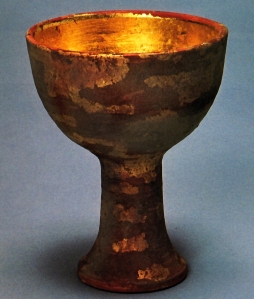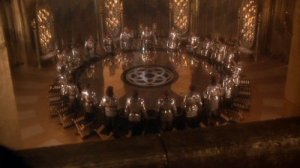I finally caved and subscribed to yet another streaming service, Apple TV+. I couldn’t resist the need to see what the new TV series would make of Isaac Asimov’s classic SF Foundation stories.
Although the book series is on the order of eighty years old, the TV series is just getting started, so I need to issue a
Asimov’s Appeal
I grew up reading the Foundation series; it was always a favorite of mine. Asimov took his premise from Gibbon’s History of the Rise and Fall of the Roman Empire (1776-1789), with a science-fictional twist.
A twelve thousand-year-old empire rules the galaxy; but Hari Seldon, inventor of a new science of “psychohistory” that statistically predicts the aggregate actions of human masses (as distinct from the acts of individual persons), realizes that the Empire is headed for an inevitable collapse. Thirty thousand years of chaos and barbarism will follow. But, while Seldon concludes the fall cannot be stopped, he does see a way to shorten the period of darkness. He establishes two “Foundations” from which civilization may be restored more quickly—in a mere thousand years. Seldon’s mathematics allows him to arrange things in such a way that the Seldon Plan will inevitably prevail—at least to a very high order of probability.
A few years ago I discussed the Seldon Plan in a post on “Prophecy and the Plan” (2018). For a more detailed description, and one reader’s take on the novels, see Ben Gierhart’s 10/6/2021 article on Tor.
The original three books consist of a series of short stories taking place over about four hundred years. There are some overlapping characters, but no character persists through the whole time period. Part of the attraction of the series is the sweep of history over many lifetimes, giving a sense of scope and gravity to the combined stories. Some of it comes from the age-old appeal of the fated outcome: we know the Plan will prevail, but how? And from the midpoint of the series on, a different question takes over: if through a low-probability turn of events the Plan is in danger of failing, can it be preserved?
We do want it to be preserved, even though the (First) Foundation is composed of fallible and all-too-human people; because the great overarching goal of the Plan is the preservation of civilization in the face of barbarism. I’ve noted before that this is a compelling theme.
Most of the original stories were first published individually in the SF magazines, and later collected into the aforementioned three volumes—Foundation, Foundation and Empire, and Second Foundation (1951-1953). Then things got complicated. In 1981, Asimov “was persuaded by his publishers” (according to Wikipedia) to add a fourth book, Foundation’s Edge. Several more followed, in the course of which Asimov tied in the Foundation series with his other great series, the positronic robot stories. The new additions in some ways sought to resolve issues in the original trilogy, and in others tended to undermine the originals. After Asimov’s death, three other celebrated authors—Gregory Benford, Greg Bear, and David Brin—were recruited to write three more Foundation books. In the last volume of this new trilogy, Brin manages to pull off a brilliant resolution of the whole series. But even that conclusion didn’t stop the flow of further related tales.
And now, as if things weren’t already confusing enough . . .
Apple’s Augmentation
A screen adaptation of the series was announced in 2017, and Apple picked it up in 2018. Asimov’s daughter, Robyn Asimov, serves as one of the executive producers. The principal writer, David S. Goyer, foresees eighty episodes—none too many for such a vast saga.
The trailers (such as this one) made it clear that the look and feel of the TV series would be rather different from those of Asimov’s cerebral books. That’s not necessarily a bad thing. The original tales have become dated in both content and style. The question is, can Apple preserve what’s appealing in the original stories, while bringing them to life for a modern audience?
We’ve now seen three episodes (the fourth premieres tomorrow). That’s not enough to allow for a full evaluation of the series, of course. But it’s fun to try and guess where it’s going and report on how it’s doing, even at this early stage. If nothing else, there’s the entertainment value, later on, of seeing how wildly inaccurate my take on the story may turn out to be. So let’s see how the adaptation stands as of the third Foundation episode.
Emperors Demand Attention
As of Episode 2, I was favorably impressed. Scores of details had been changed from the books, but often in interesting ways. For example, Asimov’s cast of characters tended to be almost all-male—although the latter half of the series did include two distinctive female characters with strong agency, Bayta Darell and her descendant Arkady Darell. The TV series diversifies the cast considerably. Seldon’s protegé Gaal Dornick is now a black woman. So is Salvor Hardin, the first Mayor of Terminus and leader of the Foundation. The technology and culture of the Empire looks pretty convincing on-screen, though it doesn’t exactly track Asimov’s descriptions. Goyer & co. introduce some up-to-date speculative ideas, such as the notion that the succession of Galactic Emperors at this time is a series of clones—though there’s no obvious reason for that last, other than to modernize the hypothetical science a bit.
The third episode, though, seems to veer away from Asimov’s basic underlying concepts. However interesting Goyer’s repeating Emperors might be, I expected us to shift away from them as the Foundation itself took center stage. But Episode 3 continued to focus a great deal of attention on the Emperors. This seems to run counter to the underlying theme that the Empire fades away as other players become ascendant on the galactic scene. I don’t know why we’re still spending so much time on the Emperors, unless they’re going to play a larger continuing role than the books would suggest—which makes me wonder what else is happening to the plotline.
Science and Mysticism
Asimov’s story, while engrossing, was essentially rationalistic. Historical events had logical explanations (generally laid out explicitly by the characters after the crisis had passed). Science, whether technological or psychological, was a dominant theme. And the key to the whole Seldon Plan concept was that the course of history is determined by economic, cultural, and sociological forces, rather than by any individual’s actions. One might agree or disagree with that premise, but it was the (I can’t believe I’m saying this) foundation of the whole original series—even though Asimov himself found a way around what might have become a stultifying predictability with the unforeseen character of the Mule.
The video adaptation points up a number of elements with a more mystical quality. The Time Vault, which in the books is merely a recording of speeches about historical crisis points by the long-dead Seldon, in the TV series is an ominous pointed object hovering unsupported over the landscape of Terminus; we haven’t yet seen what it does. The “Prime Radiant,” a sort of holographic projector containing the details of the Plan, is presented as a unique and numinous object—though that is, to be sure, a genuine Asimov detail, albeit in a different context.
More significantly, Salvor Hardin, a likeable if devious political schemer in the original stories, here appears to be the “Warden” of the Vault, a sort of Obi-Wan Kenobi figure who lurks in the desert. In Episode 3 we see her set apart even as a child; as an adult, she’s the only person who can pass through the protective field around the Vault that repels all others. One character even suggests that she may have been somehow included in the Plan.
Now, this invocation of the “Chosen One” trope is directly antithetical to the notion that history is shaped by statistical aggregates and social forces. Seldon’s Plan, by its nature, cannot depend on the unique actions of individuals. Even when Asimov introduces the Mule as a mutant with mental powers that can change the large-scale behavior of human populations, that’s presented as disrupting the Plan, ruining Seldon’s statistical predictions. To have personal qualities written into the Plan itself would undercut the whole idea. Thus, at the end of Episode 3, I’m wondering whether the TV series is going to carry through the basic Asimovian premise at all.
The Expanded Universe
The sequels to the original trilogy, first by Asimov himself and then by others, took the book series off in somewhat different directions. I’d been wondering whether the TV series would incorporate the whole “Robots and Empire” connection, or stick to the earlier structure. To that question, at least, we seem to have an answer.
A recurring character in the first three episodes is a woman, an advisor to the Emperors, who turns out in one scene to be a robot. I hadn’t caught her name at first, and had to look it up in the cast list. She turns out to be Eto Demerzel (male in the books), who is really the very long-lived robot R. Daneel Olivaw, operating under an alias. Daneel is one of my favorite characters in the early robot novels The Caves of Steel and The Naked Sun. In Asimov’s later stories he assumes a much greater importance in shaping the whole course of galactic history.
So it appears that Goyer’s version of the Empire’s history does incorporate Asimov’s later expansion of the Foundation universe, at least to that extent. It will be fascinating to see how far the writers take that connection—in particular, whether the “second trilogy” contributions of the “Killer Bs” (Benford, Bear, Brin) also figure into the plot. We’re not likely to see those ultimate developments for years (in real time), though, if the eighty-episode prediction is accurate.
Not A Conclusion
We’re still very early in the development of the Foundation video series. Tomorrow’s episode might overturn half my speculations here and send us off in an entirely different direction. But in the meantime, it’s fun to go over what we’ve seen so far and where it seems to be going—even if the secret plans of the screenwriters are as mysterious to us as the Seldon Plan is to the Foundation itself.






















